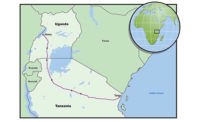Israel and Jordan have signed a final agreement to build a scaled-back version of the Red Sea-to-Dead Sea canal project, which would include a desalination plant.
The nearly $1-billion project, approved by the two countries at the end of February and sponsored by the World Bank, will serve as a pilot for the planned pipeline, which will be 10 times larger and used to pump seawater and brine into the shrinking Dead Sea.
“The desalination plant and pipeline are likely to be operational in 2020 or 2021,” predicts Avraham Tenne, desalination director at Israel’s Water Authority. The two countries decided to establish a joint administration of the project.
Jordan and Israel hope to select a consulting firm to draw up the documents for the planned build-operate-transfer desalination plant and pipeline and issue a tender early next year, Saad Abu Hammour, secretary-general of the Jordan Valley Authority within the country's Water and Irrigation Ministry, told the Jerusalem Post. Project tenders are set to be issued by year-end.
The first phase of the project involves the construction of a 70-million-cu-meter desalination plant, to be located 15 kilometers north of the southern Jordanian port of Aqaba. Under the terms of the agreement, Israel will purchase 35 million cu m of water from the plant for use in southern Israel; in return, Jordan will buy 50 million cu m of water from the Sea of Galilee that will be used to meet demand in northern Jordan.
Tenne said the planned desal project is more complex than the four plants now operating in Israel because it involves a 15-kilometer-long intake pipeline from the Red Sea, at Aqaba, and two pumping stations, which will handle the flow of brine from the plant as well as seawater through the 200-km pipeline to the Dead Sea.
Most experts concur that finding funding for the pipeline will be more problematic since it will have to come from private sources. Plant construction will be financed by water sales.
According to Professor Uri Shani, chairman of the Israeli government’s project steering committee, the pipeline will serve as a prototype for a larger version of the project, possibly costing up to $10 billion, which would involve, besides added hydroelectric plants, larger volumes of desalination and greater quantities of seawater to replenish the Dead Sea.
Five years of study, concluded in 2013, confirmed the project's feasibility and determined that the environmental impacts would be manageable.
However, Shani said the environmental impact of the smaller volumes of brine on the Dead Sea must be determined first.


Post a comment to this article
Report Abusive Comment